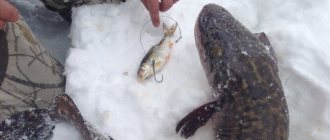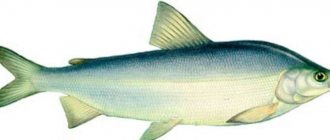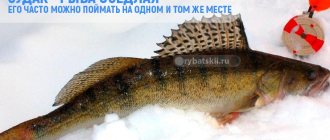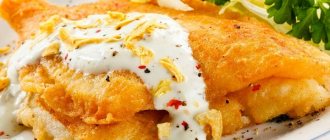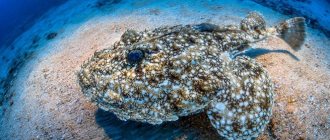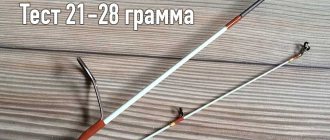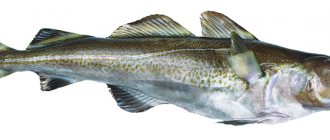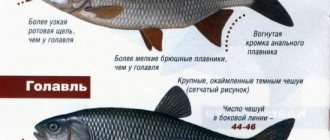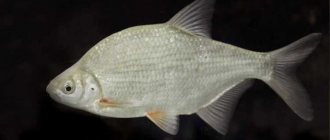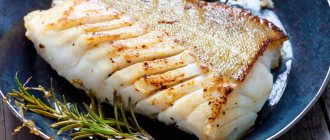What criteria must a body of water meet in order for fish to live in it?
- Even an artificial reservoir is still an ecosystem, and it takes time to build this system. Under the influence of factors such as plants planted in the water, sunlight and precipitation, the water over time acquires the necessary mineral composition and is populated with organisms necessary for fish. So, if you can plant a pond with plants literally immediately after its creation, then in the case of fish everything is different - you need to wait about a year or two. In this case, the process can be accelerated by pouring several buckets of water into the reservoir from natural analogues in which the target fish live;
- The size must be sufficient for the fish. On average, one fish 10 centimeters long will require approximately 50 liters of water. It is not advisable to put a lot of fish in small bodies of water;
- Acidity of water. It is necessary to keep this parameter within 7-8 units. Take measurements regularly using the same litmus papers or other means. If the parameter decreases or increases, use special means;
- Temperature. The ability of fish to tolerate different temperatures depends on the species, but for the most part this figure is 10-28 degrees. At the same time, it is best to introduce fish at an ambient temperature of 13-15 degrees. And so that the animals do not experience temperature shock, the container with them is lowered into the pond water for several hours until the parameters are equal. Do not forget that immediately after being added in the case of the temperature described above, at first the fish should be fed more;
- Lighting. Approximately 6 hours of direct illumination of the reservoir with sunlight would be ideal. It is better that the periods of such lighting take place in the morning and evening. Fish for the most part do not like bright light and too warm water, so during the hottest part of the day the reservoir should preferably be in the shade;
- Aeration and cleaning. Many species of fish react extremely painfully to polluted water with low oxygen content. Of course, requests vary depending on the species, but if you keep several species in your pond, then you need to proceed from the needs of the most fastidious fish;
- No less important are the depth parameters. If you want to place fish in a pond, then you need to make the depth at least 1-1.5 meters. Otherwise, the water will become very hot, making conditions very difficult for the fish. We should not forget that many fish like to go to the bottom, where it is cooler and calmer, and we must give them this opportunity.
Important! Most often, fish spend the winter in a pond, which in our latitudes is covered with ice. In this case, it is necessary to have special wintering pits in the reservoir, up to 1.7-2 meters deep.
Pond fish: a short overview
So, first, it’s worth talking about the purposes for which such fish are usually purchased. These animals have long attracted human attention with their unusualness. After all, life in a reservoir is completely different conditions and habitat, which was not always clear to people.
The need for fish arises not only in the case of fishing; in addition, many people want to create a real pond on their site in which underwater life would boil. It is in this case that pond fish are purchased. Such breeds of fish are needed precisely in order to create a natural environment in the reservoir. In general, these animals bring great benefits to the reservoir in which they live. It is worth taking a closer look at all the advantages of stocking such reservoirs with fish.
What criteria are important when choosing fish?
- Decorative fish for an aquarium in a pond will not survive for long. Primarily because they are usually small and will quickly lose in the fight for resources if they themselves are not eaten. In addition, aquarium fish are often not intended for wintering in a pond;
- Regarding size, it is better not to place large individuals in a pond, as they will overwhelm the others. Try to make sure that all the fish in the pond are approximately the same size. In this case, the ideal sizes are specimens of 10 centimeters or a little more. Their physical parameters allow them to quickly get used to new conditions;
- Character. Fish can often be called omnivores, but they must be selected in such a way as not to kill each other. It is quite logical that a pike in an artificial reservoir will very quickly deal with its other inhabitants, especially with a clear superiority in size. As with aquariums, you need to select those that get along well with each other;
- Appearance. Silver, golden, red and light-colored fish look most advantageous in the water. Dark specimens are more visible in aquariums where we look at them from the side;
- Try to purchase at least several individuals of the same species. In a single copy among other species, such a fish will feel very uncomfortable;
- When purchasing fish, it must be checked for activity, integrity of scales and absence of diseases. It is best to buy from trusted places.
Advantages and disadvantages
Before you get carp, whose homeland is Japan, you evaluate their pros and cons relative to specific conditions. The advantages of pond inhabitants are:
- omnivorous
- longevity – carp live for more than 50 years under good conditions
- attractive appearance
- undemanding
- Training – Japanese koi carp remembers up to 20 commands
- strong immunity – diseases are rare
- tolerance to low water temperature
In addition to advantages, fish also have disadvantages, but they only appear when koi carp are kept in an aquarium with a volume of less than 500 liters. The disadvantages include:
- Small size of fish - in an aquarium they grow to a maximum of 15 cm
- impossibility of breeding koi carp - spawning of koi carp is possible only if its size is at least 30 cm.
- faded color due to the tightness of the fish
- the need for a daily change of 30% water
For pond keeping there are no disadvantages.
According to breeders, the most decorative species are those with veil fins and mirror scales. Their cost is higher than that of ordinary fish, but this is quite justified. When buying carp for an aquarium, you need to inspect them. If damage or defects are detected on the body, the offered product is rejected.
This conditionally aquarium fish from the Karpov family conquers breeders over and over again. Although the aquarium hobby is fascinating, brocade carps remain primarily ornamental pond fish.
AdminAuthor of the article
Did you like the article?
Share with your friends:
The most popular types of fish for keeping in an artificial reservoir
Japanese ornamental carp
Another name for this fish is koi carp. A spotted massive fish that is distinguished by its bright colors and can change them throughout its life. They treat people well and quickly get used to them, but with fish, if they are smaller in size, they can be very grumpy. Aggression, and even eating smaller neighbors, is possible.
Among the disadvantages is the ability to grow up to a meter in length, which in turn imposes restrictions on the size of the pond - such giants will not be comfortable in a cramped body of water. Moreover, they also dig through mud with their nose, like any other carp. So a cleaning system and sufficient depth would be highly desirable. These carps are also known to have a habit of eating algae.
Common carp
They live for a long time, grow very significantly and very quickly, and are also unpretentious - they perceive the lack of food and oxygen very calmly. Carps are often settled in reservoirs by those who from time to time like to treat themselves to fresh fish.
Carp
Another unpretentious species is crucian carp. For a pond, it is worth choosing more spectacular silver or golden individuals. The expectation of a beautiful picture can be spoiled by the fact that they prefer to live near the bottom. At the same time, these fish also winter at the bottom, where they are buried in muddy sediments. In general, the fish is extremely unpretentious and incredibly tenacious. Just like carps, they are suitable for those who want to organize fishing sessions on their property.
gold fish
You should choose not aquarium options with a bushy tail, which are intended for home cultivation and may simply not survive the winter, but their more hardy pond counterparts. In general, this species shares first place in popularity with the koi already described above, and the reason for this is their excellent appearance. At the same time, this type of crucian carp survives the winter well, provided, of course, that the water receives oxygen.
Among the peculiarities of growing goldfish, it is worth noting the inadmissibility of small bodies of water (less than 40 centimeters in depth), as well as small ponds. The thing is that the species grows up to half a meter, and also likes to lift silt from the bottom and eat plants. Thus, a small reservoir will become polluted very quickly, and in order to maintain it in the desired condition, you will need to spend money on a good aeration system.
Comet
A colorful fish, usually distinguished by orange and turquoise shades in color. It is also distinguished by its elongated tail and ability to move very quickly underwater. They feel great in decorative ponds.
Bleak
Like some of the fish species described above, they love to eat aquatic plants. It is distinguished by its high swimming speed, optimal size of 10 centimeters and rapid body shape. In the conditions of reservoirs in the country or in local areas, these types of fish demonstrate their extreme unpretentiousness. The fish are often bred for fishing.
Tench
A peace-loving fish leading a sedentary lifestyle. It tolerates the company of other species well, with the exception of crucian carp. At the same time, it is extremely unpretentious to conditions, including depth. However, in the case of a large reservoir, and therefore a large area of the water surface, it can grow very strongly. And in general, this creature is growing in size very actively. Suitable for fishing.
Cold water trout
The fish looks great and is also easy to care for. The undoubted disadvantage is that it does not reproduce under artificial conditions. It readily consumes feed mixtures as food, but in natural conditions it can exhibit predatory tendencies.
Koi carp
For these fish you need a pond larger than standard and at least 2 meters deep.
Since this type of ornamental fish loves to swim and they need a large area. Koi carp have a bright red coloring. Primary color colors: white, red, yellow, cream, black, blue and orange.
In terms of feeding, Koi are not whimsical, and very often they get used to people and even allow themselves to be petted. Koi also allow themselves to be fed by hand.
Best Time to Buy Koi
Spring is a very important time to see the health status of Koi, as in winter the fish endures the cold, depleting its reserves of fat and lipids. In the spring, all fish reserves begin to be restored, and with an increase in T, various bacteria and parasites become active.
To purchase healthy Koi for your pond, you should pay attention to the following:
- For the integrity and absence of irritation on the skin of the fish;
- Carefully inspect the fins for the presence of parasites (in the form of white spots);
Proper quarantine
You should not buy one fish, it will be restless and will not take root well. After shopping in a store, it is advisable to quarantine.
The aquarium is filled with water from the pond and the fish are kept in it for a week. If all individuals are healthy, they are placed from the aquarium into a bag of water and lowered into the pond.
This is done so that the temperature in the bag gradually becomes equal to the temperature of the water in the pond. Then the fish are released. At first they will hide, then they will float to the surface.
Wintering fish
Russia does not belong to the category of countries with a warm climate. And in the vast majority of our regions, the weather has been very uncomfortable for six months or more. In winter, the reservoir can even become covered with a thick crust of ice. The fish mentioned above tolerate such conditions quite comfortably, but they need help with this.
In case of prolonged cold weather, the surface of the pond will be covered with an ice crust. As the latter grows, we must constantly check the power, and as soon as this figure reaches about 2.5 centimeters, we drill a hole in the hole and also pump out about 10-15 centimeters of water. Thus, an air gap is formed between the surface of the ice and the water, which will serve as a kind of thermal insulation.
Important! An alternative is to place a bunch of reeds in the water, which will allow air to enter the water. In addition, there are aerators and special floats used to supply water with oxygen in winter.
Feeding the fish
Fish are able to obtain food for themselves even in artificial reservoirs, eating plants and looking for something edible for themselves in bottom sediments. If the pond has the necessary ecosystem and not a very large number of fish, then it will need to be fed much less often. But this process is still necessary, and first of all we want to understand the menu of the inhabitants of our local pond.
What to feed the fish
As we said above, many fish are omnivores, so almost any compound feed sold on the market can be suitable for satiating them. In pet stores you can easily find everything you need to keep your pets well-fed, choosing one or another type of food depending on the population of the pond.
There are also alternatives for self-cooking, basically consisting of a variety of cereals and cereals, to which are added mineral components, such as the well-known chalk. Recipes can easily be found on the Internet, and they are very diverse.
Feeding method
The ideal solution is to feed the fish twice a day at the same time. The food itself can be turned into dough and thrown into water. You can use a feeder, which is simply made from a small basin with the bottom punched in several places. In this case, a rope is tied to the structure, which helps lower the food to the bottom.
Important! Look, the fish eat this or that food so well. If in some cases the inhabitants of the pond take food around the water area and do not eat, then the remains should be removed in order to keep the habitat clean.
